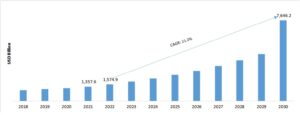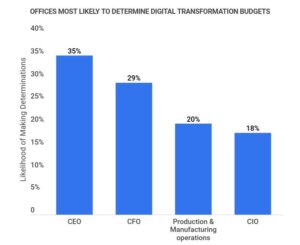
General Digital Transformation Statistics and Trends
1. Digital transformation spending is expected to reach $2.3 trillion by 2023, according to IDC.
2. 70% of companies either have a digital transformation strategy in place or are working on one, according to ZDNet.
3. 87% of senior business leaders say digitalization is a company priority, according to Gartner.
4. 40% of all technology spending will go towards digital transformation, with enterprises spending over $1.2 trillion on digital transformation in 2019, according to IDC.
5. 97% of organizations believe digital transformation is critical to their success, according to Dell Technologies.
6. 72% of organizations consider digital transformation a top priority, according to Tech Pro Research.
7. 66% of CEOs believe that digital transformation is more important than their overall company strategy, according to Gartner.
8. 40% of all technology spending will go towards digital transformation, with enterprises spending over $1.2 trillion on digital transformation in 2019, according to IDC.
9. By 2025, it is estimated that 75% of the S&P 500 will be replaced by digitally transformed companies, according to research by Innosight.
10. The global digital transformation market is expected to grow at a CAGR of 18.5% from 2020 to 2027, according to Allied Market Research.
11. According to IDC, The top digital transformation technologies being invested in include cloud computing, big data and analytics, artificial intelligence, and the Internet of Things (IoT).
12. 40% of organizations are investing in digital transformation to improve operational efficiency, while 27% are doing so to meet changing customer expectations, according to Tech Pro Research.
13. 70% of organizations believe that their digital transformation efforts will not reach their objectives without a strong focus on culture and change management, according to McKinsey & Company.
14. 80% of organizations are investing in digital transformation to increase agility and innovation, according to a survey by Forbes Insights and Hitachi.
15. 77% of organizations believe that digital transformation is a key factor in improving customer experiences, according to a report by Altimeter.
Market growth rate and adoption Digital Transformation Statistics, Trends and Forecast

The market growth rate and adoption of digital transformation are key indicators of the increasing importance of digital technologies in the business world. Here are some statistics, trends, and forecasts related to the market growth rate and adoption of digital transformation:
1. Market Growth Rate: The global digital transformation market is expected to grow at a CAGR of 18.5% from 2021 to 2026, reaching a value of $1.8 trillion by the end of the forecast period.
2. Adoption Trends: According to a survey by IDC, 89% of organizations have already adopted or plan to adopt a digital-first business strategy. This indicates a widespread adoption of digital technologies across various industries.
3. Industry-specific Adoption: The adoption of Digital Transformation Statistics varies across industries, with sectors such as finance, healthcare, and retail leading the way in implementing digital technologies to improve their operations and customer experiences.
4. Cloud Adoption: The adoption of cloud-based digital transformation solutions is on the rise, with organizations increasingly leveraging cloud computing to drive their digital transformation initiatives.
5. AI and Automation: The adoption of artificial intelligence (AI) and automation technologies is a key trend in digital transformation, with businesses using these technologies to streamline processes, improve decision-making, and enhance customer experiences.
6. Forecast for Emerging Technologies: Emerging technologies such as the Internet of Things (IoT), blockchain, and 5G are expected to play a significant role in driving the growth of digital transformation in the coming years.
7. Impact of COVID-19: The COVID-19 pandemic has accelerated the adoption of digital transformation, with businesses rapidly implementing digital technologies to enable remote work, digital collaboration, and online customer interactions.
Overall, the market growth rate and adoption of digital transformation are expected to continue at a rapid pace, driven by the increasing importance of digital technologies in driving business growth, innovation, and competitive advantage.
Digital Transformation Market Spending Forecast
According to a report by IDC, global spending on digital transformation is expected to reach $2.3 trillion in 2023, with a compound annual growth rate (CAGR) of 17.1% from 2019 to 2023. The report also predicts that by 2023, digital transformation spending will account for more than half of all IT spending. The main drivers for this growth include the increasing adoption of digital technologies by businesses, the need for improved customer experiences, and the push for greater operational efficiency and agility. Industries such as manufacturing, retail, and healthcare are expected to be the biggest spenders on digital transformation initiatives.
Digital Transformation Stats on Current Business Adoption

As of the most recent data available, digital transformation has continued to gain momentum across various industries. Here are some key statistics on current business adoption of digital transformation:
1. According to a report by IDC, global spending on digital transformation is expected to reach $2.3 trillion in 2023, representing a 10.4% increase over the previous year.
2. A survey conducted by McKinsey found that 85% of executives reported that their organizations have accelerated the implementation of digital technologies due to the COVID-19 pandemic.
3. The same survey also revealed that 58% of executives said that their digital transformation initiatives have advanced more in the past few months than they did in the previous few years.
4. Research by Gartner indicates that by 2024, 60% of enterprises will have invested in integrated business-technology teams, leading to a significant acceleration in digital innovation and business transformation.
5. A study by Deloitte found that 89% of companies have adopted or have plans to adopt a digital-first business strategy.
6. In a survey conducted by PwC, 61% of CEOs said that digital transformation efforts have helped improve their customer experiences, and 59% reported that it has increased operational efficiency.
These statistics illustrate the increasing pace of digital transformation adoption across businesses, driven by the need for agility, resilience, and innovation in an ever-evolving business landscape.
Stats on the Importance of Digitization and Digital Strategy
1. According to a report by McKinsey, companies that fully embrace digitization can see a 5-10% increase in revenue and a 15-20% increase in efficiency.
2. A study by IDC predicts that by 2022, 60% of global GDP will be digitized, with growth in every industry driven by digitally enhanced offerings, operations, and relationships.
3. A survey by Harvard Business Review found that 80% of executives believe their organizations need to develop a digital strategy to remain competitive.
4. The World Economic Forum estimates that digitalization could create up to $100 trillion in value for businesses and society over the next decade.
5. A study by MIT Sloan Management Review and Deloitte found that companies with a strong digital strategy are 38% more likely to report strong financial performance.
6. According to a report by PwC, 86% of CEOs believe that digital is their top priority for driving revenue growth.
7. A survey by Gartner found that 62% of CEOs have a management initiative or transformation program to make their business more digital.
8. A study by Capgemini Consulting found that 40% of companies implementing a digital strategy have seen significant improvements in customer satisfaction and engagement.
9. According to a report by Accenture, 94% of companies believe that digital transformation is essential for their future success.
10. A study by the Boston Consulting Group found that companies that invest in digital transformation are 1.8 times more likely to achieve double-digit revenue growth.
Cloud Adoption
Cloud adoption refers to the process of organizations implementing and utilizing cloud computing services and technologies. This can include the migration of data, applications, and workloads to the cloud, as well as the use of cloud-based tools and platforms for various business operations.
Cloud adoption offers numerous benefits, including cost savings, scalability, flexibility, and improved collaboration and productivity. It also allows organizations to access advanced technologies such as artificial intelligence, machine learning, and big data analytics.
However, cloud adoption also comes with challenges, such as security concerns, data governance, and compliance issues. Organizations need to carefully plan and strategize their cloud adoption to ensure a smooth transition and maximize the benefits of cloud computing.
Overall, cloud adoption is a critical aspect of digital transformation for modern businesses, enabling them to stay competitive and agile in today’s rapidly evolving technological landscape.
Digital Transformation facts on evolving Customer Experience
1. Digital transformation has revolutionized how businesses interact with their customers, allowing for more personalized and seamless experiences.
2. Evolving customer experience through digital transformation involves leveraging data and analytics to better understand customer behavior and preferences.
3. Digital transformation has enabled businesses to offer omnichannel experiences, allowing customers to interact with the brand through various channels such as websites, mobile apps, social media, and physical stores.
4. Automation and artificial intelligence have played a significant role in enhancing customer experience, by providing quick and efficient support, personalized recommendations, and predictive insights.
5. Digital transformation has also facilitated self-service options for customers, such as online ordering, account management, and troubleshooting, leading to improved convenience and satisfaction.
6. Businesses are increasingly investing in technologies such as chatbots, virtual assistants, and augmented reality to enhance the customer experience and provide more interactive and engaging interactions.
7. Customer feedback and sentiment analysis tools have become essential in digital transformation, allowing businesses to gather insights and make data-driven decisions to improve the overall customer experience.
8. Digital transformation has also led to the rise of customer-centric platforms and ecosystems, where businesses collaborate with partners to offer a more comprehensive and integrated experience for their customers.
9. Real-time communication and personalized messaging have become key components of digital transformation and allow businesses to engage with customers in a more relevant and timely manner.
10. As digital transformation continues to evolve, businesses will need to adapt and innovate to meet the changing expectations and demands of their customers, ultimately shaping the future of customer experience.

How do different Industries adopt digital transformation?
Different industries adopt digital transformation in various ways, but some common strategies include:
- Implementing new technologies: Many industries are adopting digital transformation by implementing new technologies. Such as cloud computing, big data analytics, the Internet of Things (IoT), artificial intelligence (AI), and machine learning to streamline operations and improve efficiency.
- Enhancing customer experience: Industries are leveraging digital transformation to enhance customer experience by offering personalized and interactive digital services. Such as mobile apps, self-service portals, and chatbots.
- Improving operational efficiency: Digital transformation allows industries to automate processes, optimize supply chain management, and improve productivity through the use of digital tools and platforms.
- Embracing data-driven decision-making: Industries are adopting digital transformation to harness the power of data and analytics to make informed decisions, identify trends, and optimize business strategies.
- Building agile and flexible business models: Digital transformation enables industries to adapt to changing market conditions and customer demands by creating agile and flexible business models that can quickly respond to new opportunities and challenges.
- Enhancing communication and collaboration: Digital transformation allows industries to improve internal and external communication and collaboration through the use of digital communication tools, project management platforms, and virtual collaboration technologies.
Overall, the adoption of digital transformation varies across industries, but the common goal is to leverage digital technologies to drive innovation, improve efficiency, and stay competitive in the digital age.
 Data Science in Digital Marketing Data Science in Digital Marketing: Mechanism Examples, Benefits Data Science Meets Digital Marketing Magic
Data Science in Digital Marketing Data Science in Digital Marketing: Mechanism Examples, Benefits Data Science Meets Digital Marketing Magic
